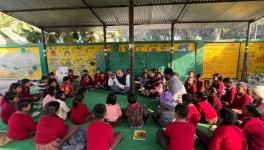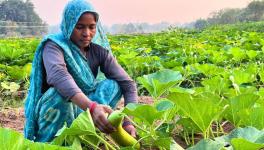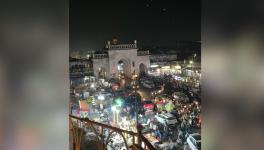UP Elections: Stray Cows Not So Holy for Farmers Spending Chilly Nights in Fields
Mathura, Agra, Etah, Mainpuri, Etawah, Kannauj (Uttar Pradesh): “Jaldi kar le, gayyan aa jaayin (do it fast, cows may raid the field),” screamed Aram Singh at his labourers who were busy loading his tractor’s trolley with potato harvest. Such is the terror of the holy cow in the northern Indian state of Uttar Pradesh where the menace of stray cattle is widely mentioned and debated among villagers.
The farmer belonging to Mahloyi village of Kurawali Nagar Panchayat (urban municipality) in Mainpuri district was upset because a herd of stray cattle had made a good portion of his crop their fodder a day earlier.
If he can sell his entire 560 quintals of potato harvest from his four-acre land to traders at Rs 4-5/kg (the present market price of white potato), he will recover his input cost — which is Rs 2 lakh. Though selling the produce at that price should make him earn a small profit of Rs 20,000-25,000, the labour cost, expenditure on transportation, packing cost, and the mandi fees would not let him do so.
He is unable to afford any losses due to the wandering animals as he had already suffered a blow of Rs 3 lakh for the last potato crop.
Cattle rearers cut their cows loose when the cattle become unproductive as their slaughter is banned in the state. As a result, big herds keep wandering the countryside, eating crops and causing road accidents. They may also be eating away at the electoral prospects of the ruling Bharatiya Janata Party (BJP), which believes hullabaloo over the popular topic of “cow protection” will help it consolidate Hindu votes and win elections.
However, the opposite might also happen. The cattle menace has upset the rural economy, which is dependent on agricultural farming. The problem has spread across the agrarian belts of Rampur, Pilibhit, and Lakhimpur in the north-easternmost district of Bareilly division, situated in the Rohilkhand region of the sub-Himalayan Plateau belt next to foothills of Sivalik Range or Mathura, Agra, Firozabad, Etah, Mainpuri, Etawah, Kannauj, Aligarh, Meerut, Baghpat, and other parts of western UP.
It has reached the extent where farmers have apparently turned against the incumbent government. This huge anti-incumbency is most likely to pose a threat to the ruling party in the state. Even those who were once admirers of Prime Minister Narendra Modi at the Centre and Chief Minister Yogi Adityanath in the state may turn against the saffron party’s government.
‘GAU RAKSHA’ VS AGRI ECONOMY
It was 1.45 am on January 20. Despite the extreme cold, a group of farmers was guarding their agricultural fields in a village in western Uttar Pradesh’s Mathura district. To keep warm, they had lit bonfires. They were keeping a vigil with high beam rechargeable flashlights at intervals.
“Wheat is growing on around 120 acres of land in the village. The cattle love to eat the nascent plant of the crop; and therefore, we have to keep awake throughout the night for its protection,” said Ashok Kumar, who owns five acres of land under wheat cultivation.
Over half of the crop in the village, he said, had already been destroyed by the stray cattle. “This happened despite our night vigil,” he added, pouring out his anger against the government.
“Sleeping at night has now become a luxury for us. We spend almost 24 hours here, but still there is no return. Input costs have gone extremely high because of sky-rocketing prices of diesel, electricity, fertilisers, etc. Farmers have to stand in long queues for DAP and urea (fertilisers) often to return empty-handed. And finally, because of the MSP (minimum support price) being just lip service of the government, we have to sell the agricultural produce in the market at throwaway prices only to recover the investment,” he said, describing the plight of farmers in the state.
“There is a blanket ban on cow slaughter, and several restrictions on its trade have made our lives a living hell. The ban is aimed at getting a political advantage, and not really protecting the cattle — which are dying of starvation and diseases in ‘gaushalas’ (cow shelters). So, enough is enough. This government must go now,” he added.
The cow is a sacred animal in Hinduism, but its rearers used to sell their unproductive bovines to cattle traders to finally sell it to slaughterhouses. So, cattle owners had a market for their aged animals, and the meat and leather industries had ready supplies of raw material.
Hindus viewed the cow as sacred but did not come in the way of Muslims, who regarded the cow as a source of meat and leather. But this equilibrium was disturbed after the BJP grabbed power in the Centre and the state.
Keeping with its right-wing Hindu agenda, the BJP government cracked down heavily on cow trade and slaughterhouses. Cow slaughter is now an illegal act in 18 states, including Uttar Pradesh. The central government in May 23, 2017, came up with an order on Prevention of Cruelty to Animals, which criminalised the cattle trade for non-agricultural purposes.
The notification was opposed by states such as West Bengal and Kerala. As a result, the Union government withdrew it on November 30, 2017.
But Uttar Pradesh approved a draft ordinance on June 11, 2020, to amend the Uttar Pradesh Prevention of Cow Slaughter Act, 1955, which strengthened the already existing law and increased the quantum of punishment for the accused.
Cattle traders in the state, who generally include Muslims, have been attacked and killed by vigilantes often linked to the BJP or local right-wing groups.
Fearing murderous attacks by vigilantes and harassment by the police while transporting the cattle, many of them have given up on the business. As a result, unproductive cows are now abandoned by their owners.
Such is not the case with buffaloes, which is nowhere spotted unattended — destroying crops, because there is no restriction on its sale and ban on its slaughter.
With the heavy restrictions on bovine trade and cow slaughter, the agricultural ecosystem — which had cattle rearing as its essential part — has been badly disturbed over the past few years. Farmers who once took pride in rearing the cattle at home now find the latter to be their biggest enemy.
Raj Kumar Gupta, a resident of Pachgai Khera village in Agra who owns two acres of land, also rears cattle for his dairy business. “We used to sell unproductive cows and male calves (which are no more used in ploughing after the use of tractors grew in farm activities) for Rs 4,000-5,000. But we cannot sell them anymore as there are no takers in the market. Left with no option, we have to leave them on the streets,” he said.
He explained that a farmer must spend at least Rs 5,000-6,000 per month on one animal. “When the cattle is of no use, it becomes difficult for farmers to maintain it,” he added.
Farmers also complained that the prices of productive cattle have also sharply declined in the past few years.
“A fertile cow, which gives 10 litres of milk every day, used to be sold earlier for Rs 40,000-50,000. Since transporting the cattle from one place to another has become very risky because of the rise in vigilante groups, who enjoy state backing, people avoid buying cattle. As a result, the price of the animal has come down to Rs 15,000- Rs 20,000,” said Rajendra Singh Katheria, a resident of Nangla Naya, Akbarpur, Auchha, in Mainpuri district.
Last season, he had sown wheat on four acres of land, and the harvest was around 20 quintals. “Had the crop not been destroyed by the stray cattle, the production would have been at least 50 quintals. I could reap the crop from only 2.2 acres, while the rest of 1.8 acres was completely destroyed by cows,” he added.
Parveen Kumar of Dabathwa village of Meerut district said the government did not do anything meaningful for cow protection and only put blames on previous governments. “If you (the government) accuse previous governments of facilitating cow slaughter, what did you really do to protect the animals? Sate-run gaushalas are there for namesake. They are in pathetic conditions in the absence of basic facilities and infrastructure. You are doing gau Raksha (cow protection) at the cost of farmers’ income,” he said.
As per the 2019 livestock survey, the state has around 1.16 million (a rise of 17.34%) stray cattle, while the country registered a decline from 2012 to 2019.
GOVT EFFORTS TO DEAL WITH STRAY CATTLE
The government claims to have taken several steps such as establishing gaushalas, cow protection centres, giving stray cows to malnourished families, adopting stray cows, levying taxes, etc.
The Uttar Pradesh’s Animal Husbandry Department claims that it has set up 545 registered cattle shelters across the state, with majority of them in most affected districts such as Mathura (38), Auraiya (35), Lucknow (18), Kanpur Dehat (13), Muzaffarnagar (13), Raebareilly (12), Banda (12), Azamgarh (11), Etawah (10), and Gorakhpur (10).
But the ground situation of these cow shelters is far from the government’s claims. They don’t have basic infrastructure and a proper fodder supply for the animal.
“In addition to the cow sheds, a total of 5,515 ‘Gau Sanrakshan Kendra’ (cow protection centres) have been opened as on January 7 this year in the state to accommodate destitute cows,” said Arvind Kumar Singh, additional director of the Animal Husbandry Department.
There is a difference between a gaushala and a ‘Gau Sanrakshan Kendra’ — the former is a permanent building, but the latter is a temporary cattle shed.
As per the official data, more than 1.3 lakh stray cattle have been adopted by 56,853 people across the state.
The government in November last year said that it was making efforts to rehabilitate around four lakh stray cattle over the next two months. It is also mulling deploying “cattle catchers” in rural areas throughout the state to bring the animals to the shelters.
In January 2019, the UP government had announced an additional tax of 0.5% to be levied on excise items such as alcohol and 1% on mandi parishads (market committees). It aimed to raise revenue for cows and stray cattle welfare.
The government had argued that it would generate a revenue of Rs 165 crore annually. However, the animal husbandry department does not have any record of the revenue raised by the cess for cow welfare in the state.
The government has recently claimed that 1,03,785 people have adopted cows under the chief minister’s cow conservation programme, namely the ‘Mukhyamantri Nirashrit Besahara Govansh Sahbhagita Yojana’, which was launched on August 6, 2019. The scheme invites people from rural pockets to take up rearing cows. And if they do so, they are paid Rs 30 per day.
But the people NewsClick spoke to were unaware of any such scheme. They said these stray cows have taken away even their nights when they go to beds to rest after day-long physical labour.
Get the latest reports & analysis with people's perspective on Protests, movements & deep analytical videos, discussions of the current affairs in your Telegram app. Subscribe to NewsClick's Telegram channel & get Real-Time updates on stories, as they get published on our website.
























